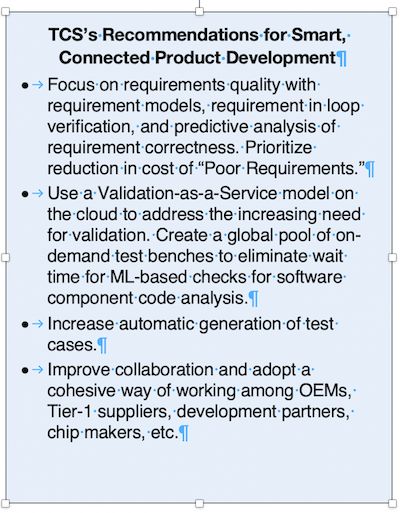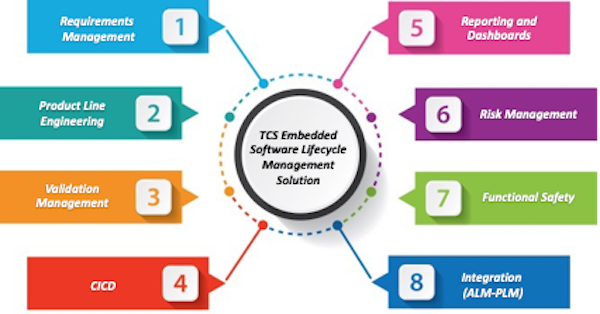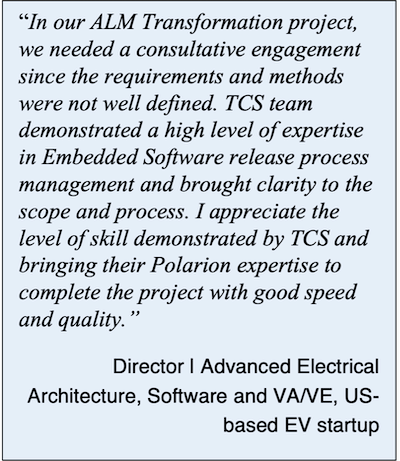Key takeaways:
- Smart, connected products are driving a major shift in how embedded software is developed due to additional product complexity, shorter development cycles, cost reductions, and quality improvements.
- A range of technologies is required to holistically support software development for smart, connected products including robust integrated tool chains that support DevSecOps, product line engineering to support reuse, PLM integration for collaboration, and AI/ML support.
- A platform approach to embedded software development is needed to support the complex requirements for developing smart, connected products.
- TCS brings thought leadership and in-depth understanding of the complex embedded software domain.
- The TCS Embedded Software Lifecycle Management offering integrates best-in-class tools into a platform with the capabilities customers need now and includes the ability to grow and change tools as requirements change.
Introduction
Most people are familiar with the growth in product complexity being driven by electrification―the addition of electronics, software, and network connectivity. We are in the middle of a massive transformation from mechanical devices driven by electrical motors and basic electrical and electronic parts to smart, connected products whose capabilities will evolve during their lifecycle.[1]
With vehicles the transformation driven by “smart, connected” is just beginning. Electric car adoption is now measurable, with many vehicles available and many more in product pipelines. The real transformation is coming from connectedness. Remote monitoring to support predictive maintenance is happening now. For example, the battery system, the heart of electric vehicles, is extremely complex with mechanical, electrical, electronic, software, and chemistry based sub-systems. Software is monitoring performance, and when anomalies are detected, they phone home to the manufacturer, let the driver know service is need, or in the most advanced cases, download new software over-the-air (OTA) to update the system.
Autonomy is currently the holy grail of automotive innovation, and if/when successful it will change how we think about car ownership and what we do in a car once we no longer need to drive. Vehicles will take themselves in for service when they can’t be upgraded OTA. Automotive is just one example: there are many other consumer and industrial use cases across industries including healthcare that will be impacted by electrification and smart, connected products.
Risks
The path to get to smart, connected products is not easy. Not only do new domains of expertise such as electrical, electronics, and software need to be established, they also need to be properly incorporated into organizations and processes, so risks are minimized and profitability and value to the customer are maximized. Complexity is a major contributor to risk, especially in products that directly interact with the physical world. In addition to complexity, connected devices have a much higher risk of security failures. Compromised devices interacting in the physical world can cause extreme failures.
With the increased complexity leading to more interaction with the physical world, many elements of smart, connected products become safety-critical. Electrified vehicles and equipment operating in automatic let alone autonomous modes must work perfectly. Executives that don’t lead their organizations to adopt new product development approaches required to address the consumer expectations and regulatory requirements will find themselves and their companies in an untenable situation.
Mitigating Risks
Fortunately, there are standards defined for the development of safety-critical systems including IEC 61508 for general industry, ISO26262 for automotive, IEC 62304 for medical, and IEC 61513 for nuclear. By defining a process to specify, code, inspect, document, test, verify, and analyze systems, safety can be ensured. But the rigors of these processes can extend development time and effort adding complexity.
Software functionality and complexity have grown exponentially and will likely continue to do so. Over the past two decades agile development has become the software development methodology of choice for addressing rapid development of complex systems and has been adopted in some form by most software development organizations. More recent developments include DevOps and DevSecOps, that tightly couple development (Dev), security (Sec), and operations (Ops), especially for cloud-SaaS environments. This approach enables higher quality code to be put into production faster because updates are released continuously in smaller increments. Testing is mostly automated, and when something does go wrong the feedback loop is shorter and traceability is more detailed leading to faster fixes.
The agile development methodology implemented within a DevSecOps environment is helping embedded software teams to transform their process to deliver higher quality software, faster, and more cost effectively especially with the growing number of safety-critical systems. A DevSecOps solution must satisfy many requirements to support the complex embedded software domain. The characteristics required to fully support modern embedded software development are shown in Table 1.
Table 1―Characteristics of a Modern Embedded Software Development Solution
- (Item)
(Description) - Integrated toolchain
Uses workflows to ensure repeatable processes and support forward and backward traceability end-to-end from requirements through code management, testing, deployment, and change management - Reuse―product line engineering
Structures product items including software to maximize reuse of proven modules to meet product variability requirements - Automation
Manages data holistically, and manual steps are minimized during the software development lifecycle (SDLC) - Artificial Intelligence / Machine Learning (AI/ML)
Incorporates AI/ML capabilities in both the development of embedded solutions and the execution of embedded software to improve product performance - Analytics
Provides reports for all phases of the SDLC - Cloud-DevSecOps
Integrates development and operations of embedded software in smart, connected devices including proper security management, running on the cloud providing bidirectional communication to support data acquisition and over-the-air (OTA) updates - Ability to manage large data sets
Captures and manages data from test phases and especially operations (e.g., test data management and IoT) and ensures data is consumable anywhere in the SDLC and product lifecycle, especially by analytics solutions - Domain specific capabilities
Provides industry-specific embedded software management such as to support A&D, automotive, and healthcare requirements and nomenclature, especially regarding compliance - Eco-system collaboration
Integrates SDLC into the product lifecycle management solution to ensure effective collaboration - Developer productivity
Supports tools and processes to help developers generate higher quality solutions faster - Compliance
Ensures industry specific compliance requirements are satisfied as required by their specific industries
TCS’s Approach

TCS has extensive experience in designing and managing embedded systems and has worked with leading OEMs to help them develop new products.
Leveraging this experience, TCS has assembled a framework known as TCS Embedded Software Lifecycle Management solution that supports a variety of application lifecycle management (ALM) solutions such as IBM, Polarion, Atlassian, and Codebeamer[2] and includes integration with leading PLM solutions such as Teamcenter, ENOVIA, and Windchill. Figure 1 shows the capabilities available within their framework which align with the previously described requirements in Table 1.

Figure 1―TCS Embedded Software Lifecycle Solution Capabilities
The TCS solution is more than just software and integrations. It includes knowledge developed from many customer engagements as well as from internal use within TCS. TCS also helps clients develop an appropriate embedded software development strategy and select and deploy the best solutions to meet strategic requirements. The capabilities shown in Figure 1 are worth calling out individually.
- Requirements Management―Software related product features and requirements captured in PLM are allocated to ALM to streamline the software development process. Requirements get decomposed in ALM with an appropriate level of abstraction and structure. Requirements modeling and requirements in loop verification ensure quality, coverage, and correctness. Compliance checks ensure requirements are robust.
- Product Line Engineering―To deliver product variants within a short time, re-use of engineering artifacts is a must. The feature-based approach of product line engineering enables reuse. The solution includes a product feature library, to enable management and reuse of the artifacts (requirements, models, test plans, code, etc.).
- Validation Management―Increases in complexity of product software and compliance requirements demands higher quality validation. System and software validation covers different model types such as model-in-the-loop (MIL), software-in-the-loop (SIL), and hardware-in-the-loop (HIL) as well as integration validation, etc. The integration of the ALM platform with test tools and automation improves validation coverage, efficiency, and reporting. TCS SIMPLE, a part of the Autoscape 3 suite analyzes complex test structures to identify edge cases.
- CICD―Continuous Integration/Continuous Development along with verification, reporting and monitoring ensure software quality. Build time optimization, binary management, containerization, and test automation are key aspects of the solution. This state-of-the-art methodology effectively supports DevSecOps and ensure traceability across the entire SDLC.
- Reporting and Dashboards―Common, organization-wide, role-specific, and real-time dashboards help stakeholders improve their decision-making process. Reports and dashboards support software lifecycle KPIs―validation coverage, requirement coverage, code quality, build status, compliance data (e.g., Automotive SPICE), etc. AI/ML-based reports help stakeholders monitor and optimize processes.
- Risk Management―Identifying and mitigating risk is critical in all industries, especially when there is a need to comply with ISO14971. The TCS solution covers the digitization of risk analysis, evaluation, maturation, and control using ALM tools.
- Functional Safety―Managing functional safety is critical for any product and organization’s need to comply with regulations such as ISO26262. TCS solution covers all aspects of managing the safety artifacts from item definition to identification of hazards to decomposition of functional and technical safety requirements.
- Integration―PLM is the backbone of product lifecycle development and manages the release and maintenance of product related information. With Multi-domain changes it becomes critical to synchronize the software related changes between PLM and ALM. Once the software is ready for release the binary must be properly linked to the product configuration. ALM-PLM integration is the key to ensure collaboration between the domains. The TCS solution supports integration using various technologies such as OSLC, middleware, point-to-point, microservices, and REST-based solutions.
TCS’s Autoscape product discussed in this commentary[3] is based on the TCS Embedded Software Lifecycle Management Solution with TCS’s value-added products to round out the platform. CIMdata found this to be a compelling solution for the development of autonomous products as did the company mentioned in the commentary case study demonstrating the value a platform approach can deliver.
TCS Support for EV Startups

TCS was selected by a US-based EV startup organization to help them on their ALM journey. The organization wanted to implement an ALM platform to support their product software development lifecycle to help them meet a short vehicle launch timeline. The company expected the partner would bring domain and technology expertise and implement a solution using an agile methodology. TCS implemented appropriate solutions from their platform including requirements management, validation and test automation, CICD, device transmittals management, reporting and dashboards, ALM-PLM integration, and multi-domain BOM management within the stipulated time. This resulted in the solution being well accepted by the user community.
Conclusion
As smart, connected products grow in number, volume, complexity, and inter-connectedness the challenges of embedded software development grow in parallel. New development approaches, especially for embedded software, must be adopted to successfully meet quality, timeline, and cost requirements. The complexity challenge has many dimensions including application functionality, ever shortening timelines, security, reuse, and others. To successfully deliver products companies want a one-stop-shop but they also want to use best of breed tools, a divergence in approaches. TCS’s Embedded Software Development Framework delivers a best-of-breed platform that allows mixing and matching of the major PLM and ALM solutions along with focused tools to create a sustainable embedded software development platform. Systems integration is a sweet spot for TCS, and by building a platform based on best-in-class tools that is maintainable and supportable they can meet their customers’ normally conflicting requirements. TCS has the software implementation skills to build and manage the platform and create specialized applications when needed. They also offer consulting services to help customers define, select, and deploy their ALM landscape. Contact TCS to learn more about their embedded software development solution.
[1] Research for this commentary was partially supported by TCS.
[2] Recently acquired by PTC, https://www.cimdata.com/en/resources/complimentary-reports-research/commentaries/item/18428-ptc-acquires-intland-software-highlight
[3] https://www.cimdata.com/en/resources/complimentary-reports-research/commentaries/item/15283-tcs-s-autonomy-framework-autoscape-commentary







